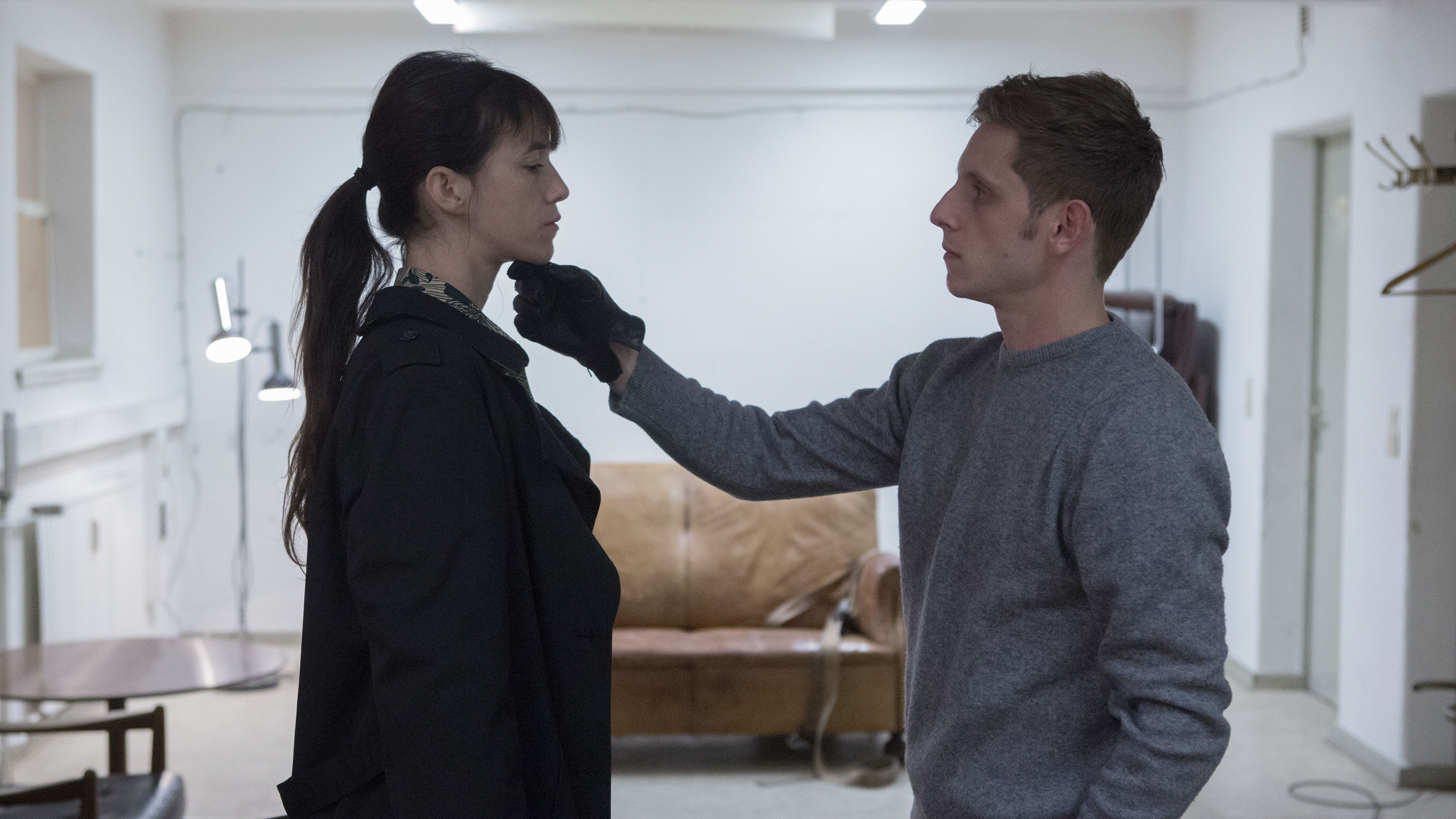PAnita
Opens Fri., April 4 at Sundance Cinemas. Not rated. 77 minutes.
You may find yourself wondering, in the opening minutes of this new documentary, which returns to the events of 23 years ago, why now? It’s a short-lived question. Within minutes, you find yourself immersed in a tale as riveting now as it was in 1991, when an unknown University of Oklahoma law professor named Anita Hill spoke up about the sexual harassment she said she’d endured at the hands of then–Supreme Court nominee Clarence Thomas.
Hill’s astonishing poise during a nine-hour grilling by a Senate committee continues to amaze. And Oscar-winning director Freida Lee Mock (Maya Lin: A Strong Clear Vision) deftly blends in details about Hill’s life. We visit the Oklahoma farm where she grew up as the youngest of 13 children, watch her close-knit family rally around her, and much later meet the man who’d become her long-term partner. The unseemly reception this 35-year-old black woman got from a panel of mostly hostile, insensitive senators—all of them old white men—is perhaps even more striking now than it was then. Even current Vice President Joseph Biden, then the chair of the Senate Judiciary Committee, comes off looking bad as he asks Hill to repeat the lurid details of Thomas’ reputed harassment again and again.
Yet Anita is equally about Hill’s second act in life. It’s a dramatic story, as she’s vilified by Thomas’ defenders and driven out of the teaching job she loves, then later finds a job at an even more prestigious university (Brandeis) and a new orientation as a passionate advocate of gender equality. There are moving moments here, like when we follow Hill to her basement where rows of file cabinets contain thousands of supportive letters she has received over the years.
The film loses some of its power as it drifts into scenes of Hill at various female-empowerment talks and workshops. And it makes no pretense at balance: Thomas’ side of the story is absent. But you forgive Anita its sins, because it brings us closer to a woman whom we’ll likely still be talking about 20, 30, even 50 years from now. Nina Shapiro
Captain America: The Winter Soldier
Opens Fri., April 4 at Majestic Bay and other Theaters. Rated PG-13. 136 minutes.
The recent spate of superhero movies all share the same peculiar dynamic. After being dropped from buildings, incinerated, and slammed with high-speed projectiles, their characters invariably end their epic battles with a definitive . . . fistfight. You can’t kill them with incredible punishment, but a bout of pugilism is supposed to settle things. In the end, of course, a black hole or something opens up and withers the villain’s magic skill set. But it says something about these oversized productions that they need to bring everything down to hand-to-hand basics—as though somebody realized how dull a movie can get when the antagonists can’t actually be hurt.
The same outline prevails in the second top-lining film for its old-fashioned superhero. And the first thing to be said about this one is that, unlike 2011’s Captain America: The First Avenger, which existed purely to set up Marvel’s 2012 ensemble summit meeting The Avengers, Winter Soldier is actually a movie: It has a story, a subtext, and a few fun pulp surprises along the way. Chris Evans returns to the title role; his cheerful calm is the closest anybody in this cycle has come to summoning Christopher Reeve’s buoyant comic-book presence from the first couple of Supermans. Cap finds his 1940s-era mindset challenged by the surveillance-state approach of a government minister (Robert Redford, cleverly cast), and his existence threatened by the mysterious Cold War–era nasty known as the Winter Soldier.
Someone had the useful idea to let Samuel L. Jackson, returning to duty as one-eyed Nick Fury, actually get knee-deep in the action here. Same with Natasha Romanoff (Scarlett Johansson), who is allowed much teasing of the all-American hero. New to the squad is an Iraq War vet (Anthony Mackie, from The Hurt Locker) game for some dedicated male bonding. The film scoots right along and scatters around some effective jokes, which is more than can be said for the previous comedies by directors Anthony and Joe Russo (Welcome to Collinwood ; You, Me and Dupree). It builds to the inevitable gigantic special-effects smackdown with the fate of millions hanging in the balance—and of course a preview scene at the end, pointing the way toward Joss Whedon’s 2015 Avengers sequel. The computer-generated climax will either be tedious or thrilling, depending on your tolerance for the digital battlefield, but there’s something to be said for the movie’s basic competence. And if, on top of all the hardware and massive destruction, you really need to see Captain America and the Winter Soldier socking each other in the jaw, you won’t be disappointed. Robert Horton
Cheap Thrills
Runs Thurs., April 3–Thurs., APril 10 at SIFF Cinema Uptown and SIFF Film Center. Not rated. 85 minutes.
Intentional or not, the setup to Cheap Thrills recalls Joel Schumacher’s 1993 man-in-a-rage thriller Falling Down. In that film, Michael Douglas played an uptight, bespectacled man thwarted by divorce, a pink slip, and a busted air conditioner. Here the bespectacled hero is Craig (Pat Healy), a failed writer beset by a needy (yet loving) young family, a pink slip, and an eviction notice. It’s not a particularly artful way to start a story; in both these films the tear-down’s clumsy quickness ups the anxiety but spares the nuance. And yet this is an effective hook, as old as George Bailey: With a man stripped almost entirely of ego at a point of pure desperation, a filmmaker can do anything he wants. Schumacher sent his bottomed-out protagonist on an angry rampage fueled by white-male entitlement. Director E.L. Katz takes Craig on a very different journey of human debasement.
Here’s how it goes. Craig walks into to a bar, runs into an old skateboarding buddy named Vince (now the muscle for a bookie), and shares his misfortune. Then a rich guy and his cellphone-twiddling wife show up and begin throwing money around, paying Vince (Ethan Embry) and Craig to do shots and act like clowns. These dares-for-cash lead the two buddies to the couple’s house, where they realize they’ve stumbled into a high-stakes contest that Colin (David Koechner) has arranged to entertain his wife Violet (Sara Paxton) for her birthday.
There’s nothing clever about the plot or interesting about the characters, briefly sketched by Katz as a formality before pushing his pawns into the game. But there is a kind of Jackass-style tension here, as we try to guess what new disgusting trick will be requested of these two marionettes. Cheap Thrills is a dumb gross-out flick at its core, salted with a bit of social commentary. Its obvious subject is the voyeurism that drives the ratings for shows like Survivor or—as seems more the inspiration here—the dearly departed Fear Factor. Instead of eating Madagascar hissing cockroaches, though, Katz has his contestants chopping off digits and eating the neighbors’ dog. (Note: Healy will introduce Thursday’s screening at SIFF Cinema Uptown.) Mark Baumgarten
Hide Your Smiling Faces
Runs Fri., April 4–Thurs., APril 10 at Northwest Film Forum. Not rated. 81 minutes.
In his first feature, writer/director Daniel Patrick Carbone follows a motley group of boys, 9-ish to teenaged, as they tromp through the woods, swim in a pond, explore an old railway viaduct, ride bikes, and wrestle in the grass. Not much is said during these endless summer days, and the lovely widescreen scenes could almost pass for Terrence Malick until the plot kicks in. One of the younger kids has a compulsion, the way some boys do, to borrow and show off his father’s handgun. It gets passed around, pointed (none check to see if it’s loaded), and becomes the object of some roughhousing.
Naturally we expect the worst, but Carbone follows a very meandering path through his forest. Teenaged Eric (Nathan Varnson) is usually tailed by his timid little brother Tommy (Ryan Jones), who’s afraid of heights, afraid of the water, and maybe hoping that Eric’s muscled confidence will rub off on him. Eric naturally teases his kid brother, but he’s also protective; they seem closer to each other than to their parents. (Only one adult figures prominently in the film.) How should these siblings respond to death? The film is full of it, beginning with the very first shot, yet it’s mostly animals who meet their demise. Tommy’s at the age where poking dead birds and dogs with a stick is natural and normal. Eric’s past that and impatient with the morbid natterings of his friend Tristan (Thomas Cruz). Why would anyone want to die? To the strappingly physical Eric, that’s crazy talk.
In this somber never-never land without cell phones or videogames, Carbone certainly creates a mood, but it’s the atmosphere of a terrarium. The suspense goes nowhere; and the death of a child becomes mere contrivance for much angsty moping. The film never achieves any mortal profundity, only pokes it with a stick. Brian Miller
PIl Sorpasso
Opens Fri., April 4 at Varsity. Not rated. 102 minutes.
Rarely screened in the U.S., newly restored for its Criterion DVD release later this month, this 1962 Italian road comedy was a huge hit at home but virtually unseen here. Why? It came out during the art-house epoch of Fellini and Antonioni, whose L’Eclisse gets a succinct critique from Bruno (Vittorio Gassman): “I couldn’t keep my eyes open!” Speeding into the picture in his Lancia convertible (equipped with a record player!), the 40-year-old Bruno is open to everything in life. He flirts with every woman in sight; he drives like a maniac; he makes shady business deals on the fly; and he spontaneously befriends shy young law student Roberto (Jean-Louis Trintignant), dragging him along on a weekend road trip.
Their picaresque circuit leads north from Rome, shuttered during August vacation, to various beach towns, restaurants, and clubs. Meanwhile we hear self-conscious Roberto’s interior monologues; he frets that he’s “too uptight,” the type who always looks before leaping. On one level, the lusty, vital Bruno will teach Roberto how to live il sorpasso (“the easy life”), but Dino Risi’s film is far slyer than its odd-couple construct. In an astonishingly forceful and unfolding performance, Gassman reveals Bruno to be a man of depth and soul, not just some rogue. Equally, these antics show traditionalist Italy lurching into the ’60s. The space race, Jackie Kennedy, Khrushchev, and Sophia Loren are all referenced; yet a bikinied teen can also mock the brooding Roberto as “Young Werther”—Goethe and go-go dancing go together, along with pratfalls, philosophy, and young love.
Back to the issue of respect. Il Sorpasso is beloved by Martin Scorsese and Alexander Payne, who saw it decades after The
New York Times misjudged the film as an “examination of an aimless wastrel and his destructive effect on an idealistic youngster.” Wrong and wrong. Nothing is wasted on Bruno, who opens Roberto’s eyes to life lived both high and low, where risk is inseparable from reward. Brian Miller
In the Blood
Opens Fri., April 4 at Sundance. Rated R. 108 minutes.
We have Steven Soderbergh to thank for making former MMA fighter Gina Carano into a big-screen action heroine with his 2011 Haywire, but he’s moved on to other things. So does Carano fade back into B-movies, or does she have the charisma to complement her elbow punches and knee stomps? To be sure, she carries this thriller about a woman trying to rescue her husband from kidnappers in an unnamed banana republic; but then, it’s not a very big lift. Directed by John Stockwell (Turistas, Blue Crush), the movie has a much different pedigree than Haywire. In this honeymoon-gone-bad is a Club Med aesthetic of GoPro cameras, zip lines, selfies, Snapchat, and narcoterrorists. Carano is supported by veteran faces (Treat Williams, Danny Trejo, Luis Guzman, etc.), but the real test is whether she needs a man to save her in the end—or the other way around.
In flashbacks, we see how young Ava’s father (Stephen Lang) taught her the art of self-protection. A decade later, her new WASP family is suspicious of this interloper from the barrio. Ava’s husband (Tacoma native Cam Gigandet) reads like a bland, handsome Bennington dropout; he’s the one who’s married up. In truth, we don’t really miss him once he’s been nabbed, but Ava is relentless in her battles with corrupt cops and Caribbean drug lords. “Where’s my husband?” she snarls, beating confessions out of suspects like Jack Bauer. Instead of Tiger Mom, we have Tiger Wife. Though not a great actress, Carano moves with a healthy, physical pride—ready to be somebody’s mentor and martial-arts trainer. If Carano could only grab better roles, she might be the tough older sister to the Hunger Games’ Katniss Everdeen or Divergent ’s Tris Prior. Brian Miller
PThe Missing Picture
Runs Fri., April 4–Thurs., APril 10 at SIFF Film Center. Not rated. 92 minutes.
The Holocaust was well documented, both by Nazi bureaucrats in their ledgers and Jewish families with their diaries and photo albums. This was not the case during the 1975–79 Khmer Rouge terror in Cambodia, when some 1.8 million perished (about 21 percent of the population) under the genocidal policies of Pol Pot. I give you those numbers because Cambodian director/survivor Rithy Panh does not in his unique and harrowing personal essay film. There’s no voice but his, no perspective but his, and an evidentiary void that he fills by hand. Panh’s whole family was exterminated, leaving hardly a photo or letter behind. Four decades later, living in France, he decides to recreate their record—and by extension Cambodia’s—using crude little painted-clay figurines, placed in tiny film sets, plus archival footage and Khmer Rouge propaganda films.
Panh’s narration muses on many subjects: his schoolteacher father’s love of literature; his musician brother’s disappearance in Phnom Penh before Pol Pot’s “Year Zero” was declared; then the brutality of four years in a labor camp—starvation, children denouncing parents, executions, and worse. “How is it that I’m here?” the grown Panh asks. He works through the answers in small, static dioramas: atrocity reduced to the tabletop, human suffering at 1/32˝ scale.
While the Khmer sought to “perfect” society by destroying the bourgeoisie, Panh’s little clay figures—eyes and mouths sometimes locked open, as if screaming—are rough-hewn and defiantly imperfect. Each tableau illustrates Panh’s account with almost childlike simplicity, so unlike the Khmer’s chillingly staged propaganda reels. In the latter we see the endless snaking line of a basket brigade, moving earth by hand to create a dyke or levee. The procession has been cruelly choreographed for the camera, a revolution realized only on film, says Panh. His humble effigies contradict that totalitarian impulse. This is an alternate handmade history, incomplete and sometimes opaque, unlike anything you’ve ever seen. Brian Miller
Nymphomaniac Vol. II
Opens Fri., April 4 at Harvard Exit. Not rated. 130 minutes.
Seeing Nymphomaniac Vol. II a couple of weeks after Vol. I is more than just a case of cinema interruptus. It proves how much the opus needs to be seen as a single picture, preferably in one go. So intriguing in its first couple of hours, Nymphomaniac scrambles to get back into gear as Vol. II resumes the story; more nagging still is the feeling that while the material darkens, it doesn’t necessarily deepen.
We return to the room where Joe, a no-longer-young sex addict—though she prefers the term nymphomaniac—is recounting her life story to the intellectual Seligman (Stellan Skarsgård). Joe continues her journey through a variety of partners, willing to lose husband (Shia LaBeouf) and child in order to be on time for her abusive appointments with a whip-cracking sadist (Jamie Bell). Joe is once again played as a young woman by Stacy Martin, though Charlotte Gainsbourg takes over the lion’s share of the flashbacks before long.
Lars von Trier appears to be making a movie about female sexuality—but maybe not. I wonder whether this half of the film suggests more strongly that Nymphomaniac is really about everybody else in Joe’s life, all the people who must grapple with her brazenly stated appetite for sex. From the enigmatic Seligman (the film’s real suspense is how the present-day segment will end) all the way down to the hapless translator who facilitates a bilingual liaison, the ranks are filled with people who can’t handle Joe’s ongoing search. And the movie viewer, having been drawn toward this mostly non-erotic movie full of nudity and brutal sexual violence, is implicated in that circle as well.
It’s hard to settle on von Trier’s purpose, although he baldly offers many possible readings, from people’s desperate need to fill the void of their existence to the idea that power and pleasure might be gained by ceasing to strain against one’s chains. Any conclusions are complicated by reports that von Trier’s preferred cut of the whole movie is an hour longer than these two combined installments, which might explain why the final chapter—involving Joe’s curious work as a bill collector for gangster Willem Dafoe—seems under-dramatized. One thing would presumably remain the same in a longer movie: the bleakness of the fade-out. Von Trier’s view of humankind has not sweetened in the course of this journey, and we shouldn’t be shocked if he leaves us literally in the dark. Robert Horton
E
film@seattleweekly.com






